Pique fabric is distinguished by its rough texture and distinct weaving. It is loved for its versatility, comfort, and long-lasting use. In this post, we’ll discuss what pique fabric is, its essential characteristics, everyday applications, and its entire manufacturing procedure.
What is Pique Fabric?
In contrast to plain weaves, pique uses different yarns in elaborate weaves. This gives it its distinctive matte appearance. It’s most commonly used in polo shirts, which take advantage of its wicking and tacky properties.
History and Origin
Pique fabric is a long-standing tradition dating back to 18th-century Europe. It began as a mimic of corded quilts and found its way into fancy dresses and decorative fabrics.
Hemp is able to grow with much less water as compared to cotton. This low water requirement renders it appropriate for the areas that face water shortages. Polyester, on the contrary, comes from petroleum and has a much larger carbon footprint. With such a low water requirement, no need for pesticides, and the ability to absorb carbon, hemp can indeed be called a green leader among the fiber crops.
In contrast to plain weaves, pique uses different yarns in elaborate weaves. This gives it its distinctive matte appearance. It’s most commonly used in polo shirts, which take advantage of its wicking and tacky properties.
Properties of Pique Fabric
By grasping what makes pique fabric so distinctive, we can better understand its popularity.
Texture and Appearance
You can identify pique fabric by its grainy texture. It has a stepped weave that is pleasing to the eye and touch. They could include fine ribbing or complex geometric patterns such as bird’s eye or honeycomb.
Breathability and Comfort
Pique is renowned for its breathability. The rough texture creates tiny air pockets that facilitate ventilation. That makes pique fabric clothing ideally suited for warm weather and sportswear.
Durability and Strength
Pique is not only attractive but also durable. The weaving pattern improves the wear resistance of the fabric and ensures it can be used and washed many times without becoming warped or brittle.
Moisture-Wicking Ability
One of the most remarkable features of pique fabric is its ability to wick moisture away. It keeps the wearer dry, thereby being used as sportswear.
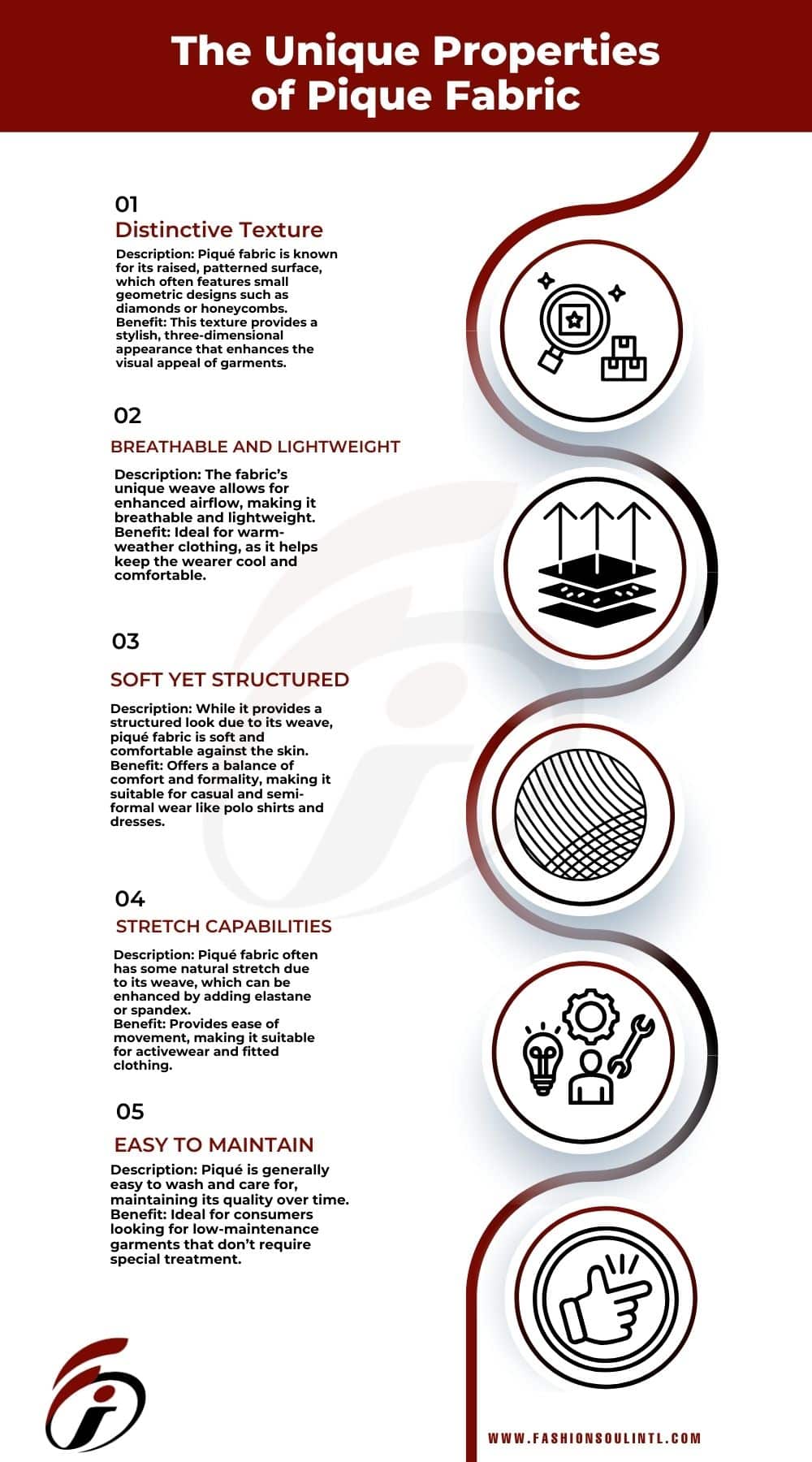
Types of Pique Fabric
All varieties of pique fabric have different uses and desires. Here are the most widespread varieties:
Single Pique
Single pique is a specific fabric composition found on polo shirts, sportswear, and everyday wear. It has a distinctive sheen—fine, jagged edges that leave a waffle or honeycomb pattern on the fabric. This feel improves ventilation and wicking, making single pique an ideal material for summer clothing. The fabric is generally cotton or a cotton-blend, providing longevity, comfort, and softness. Single pique is popular because it has an unobtrusive combination of the traditional style with practical attributes that suit the wearer, for both casual and athletic occasions.
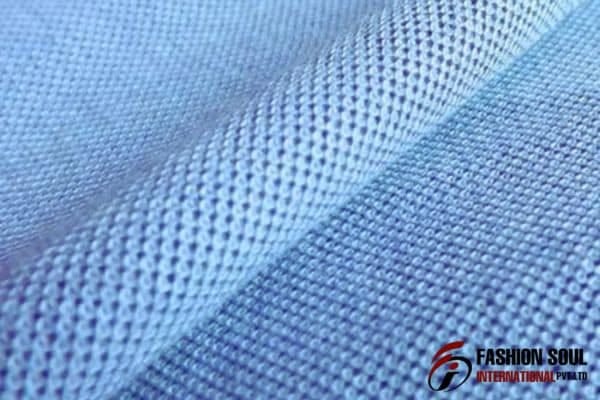
Double Pique
This fabric provides more durability and texture. It is woven in two layers rather than one, giving it a much more robust feel. It is an ideal fabric for activewear, as it provides extra durability while being breathable. Besides, double pique is very wear-resistant and therefore perfect for long-lasting apparel. Furthermore, the soft surface of the shirt keeps you dry and cool. Thus, double pique is a great choice for sportswear and casual wear because it’s both practical and trendy.

Bird’s Eye Pique
Pique fabric stands out for its subtle, distinctive pattern that resembles tiny “bird’s eyes” spread across the fabric surface. This unique texture not only adds visual appeal but also gives the fabric a refined, sophisticated look. Furthermore, the small, eye-like patterns enhance the fabric’s charm, making it a popular choice for those seeking elegance in their clothing. As a result, this fabric remains a favorite in both casual and formal wear, bringing a touch of texture and style to every garment. It’s a fine, lustrous fabric that we often find in both casual and formal dress shirts, making them look sharp and sophisticated. The fabric’s weave has a unique texture that creates interest without overwhelming the entire appearance and is ideal for trendy yet professional looks.
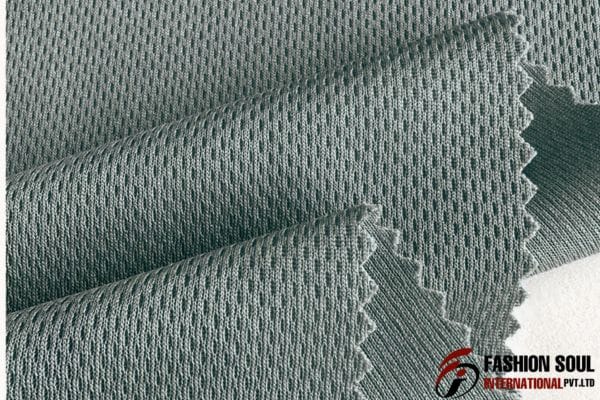
Honeycomb Pique
The honeycomb pique version is intended to add more depth and texture to the fabric. This fabric, featuring a honeycomb pattern that gives it a unique texture as well as an enhanced look and feel, is perfect for luxury clothing. Honeycomb pique, unlike other fabrics, is woven so that it feels supple and instantly improves the garment’s appearance.
This is why designers widely choose honeycomb fabric for crafting high-end polo shirts, dress shirts, and even tailored garments. By selecting this fabric, they bring sophistication and a premium feel to any outfit. Additionally, honeycomb pique enhances the overall structure of the clothing, giving it a refined, polished look that stands out in upscale fashion. As a result, it has become a go-to material for those aiming to create luxurious and stylish pieces.
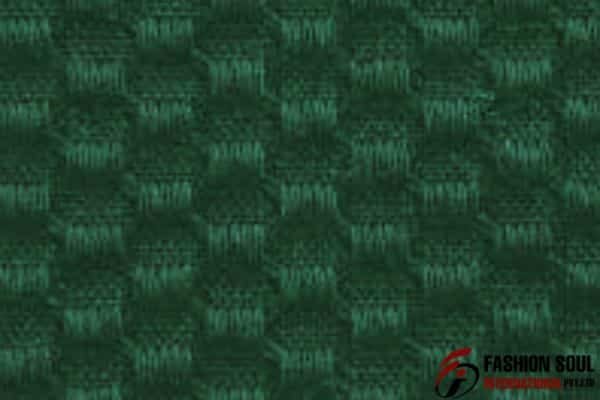
Manufacturing Process
The very first thing when you knit pique fabric is to choose the yarn that is right for you. Premium cotton is generally the preferred material for its softness and wicking abilities. The fabrics are sometimes blended with polyester or spandex for added tensile strength or elasticity.
Weaving Techniques
In the weaving process it is made with a dobby loom, creating different designs and variations. Weaving involves laying yarns in combination to form raised surfaces. This process distinguishes fabric from less intricate woven fabrics.
Finishing Processes
When the fabric is woven, it goes through various finishing procedures to get the finish that suits it best. This can be softened, bleached or pre-shrinked to keep the fabric as large and flexible as possible.
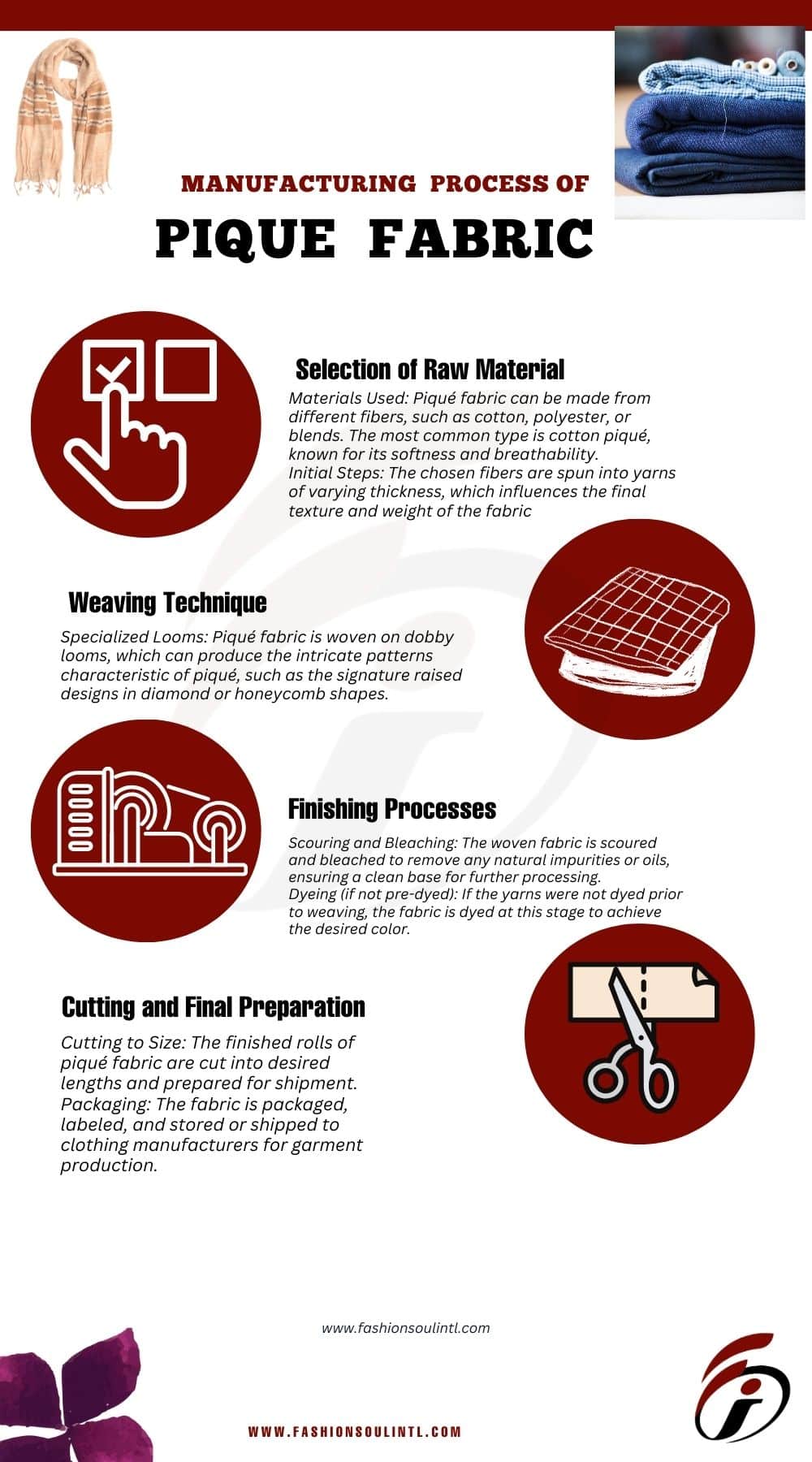
Common Uses of Pique Fabric
This material is highly versatile. Its uniqueness enables it to be used in a wide range of applications:
Pique fabric uses in Fashion Industry
Polo shirts are likely the most popular example of pique. The breathability and structure of the fabric are just what we need for functional but fashionable clothing. Designers also use it for blouses, dresses, and casual shirts.
Sportswear and Activewear
Because it wicks moisture and breathes, pique is the perfect fabric for sportswear. It keeps athletes cool and comfortable, even during intense workouts.
uses of pique fabric in home textiles
In addition to fashion, pique is used in domestic textiles. Pique cushion covers, bed linen and tablecloths have the texture that makes them elegant.
Accessories and Beyond
We also can use this for handbags, hats, and fashion accessories. The formality of the fabric gives these pieces a classy appearance.
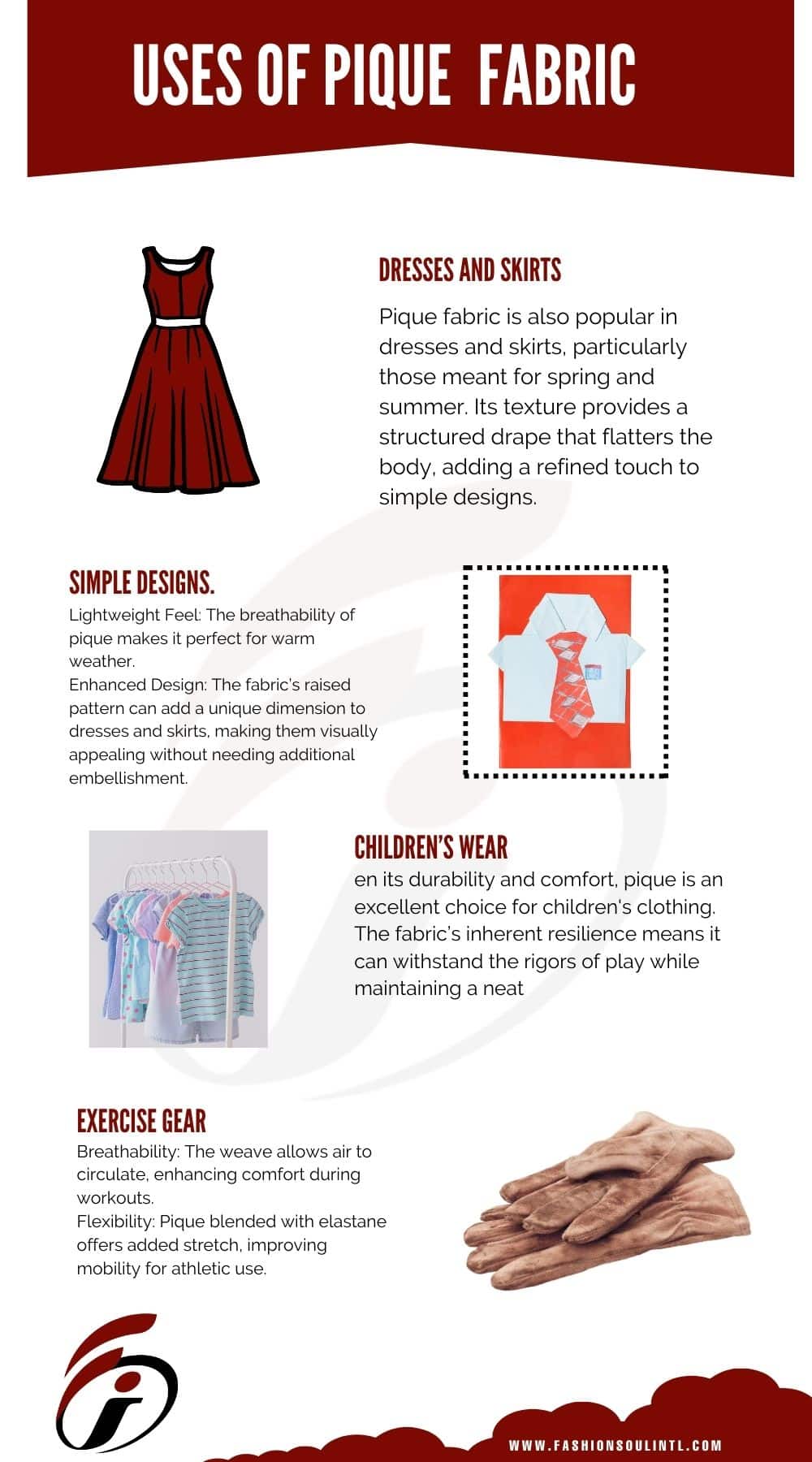
Advantages of Using Pique Fabric
Pique fabric provides a number of benefits:
- Comfortable and Ventilated: For outdoor and daily usage.
- Graphite Look: Textured designs add a visual appeal to the fabric.
- Strong: Can be washed and used repeatedly.
- Moisture-wicking: Keeps the wearer dry by diverting sweat from the body.
Limitations of Pique Fabric
Pique fabric has many advantages, but also drawbacks:
Wrinkling: Depending on the mix, it may wrinkle.
Shrinkage Risk: Certain varieties may shrink without treatment.
Not as Flexible: Unless you incorporate elastic fibres, pique isn’t as stretchy.
Sustainability in Pique Fabric Production
ncreasingly concerned with the environment, companies target green solutions. Organic cotton pique and ethical dyeing are on the rise. These techniques reduce the waste produced from pique cloth.
Caring for Pique Fabric
To care for this material, follow these straightforward instructions:
Washing Instructions
Use a mild detergent to wash in cold or warm water. This maintains the fabric’s structure and avoids shrinkage.
Ironing and Storing Tips
Turn iron low to avoid ruining the texture. Hold pique clothes upright or hang on hangers to keep them shape.
FAQs
Pique fabrics primarily consist of cotton, but may also contain polyester or spandex.
Yes, pique is breathable, which makes it perfect for warmer weather due to its light texture.
In fact, some pique fabrics can shrink, especially when not pre-shrunk or washed improperly.
Wash in warm or cold water with mild detergent. Don’t use harsh chemicals or excessive heat.
In the Summery
Pique fabric is very unique in terms of breathability, ease and appearance. Its variety of uses, from polo shirts to home furnishings, demonstrate its adaptability. It is by understanding its nature, manufacturing and care practices that you can truly grasp the goodness this fabric offers. From casual wear to workout apparel and household fabrics, pique is the way to go.
What is satin fabric?
A special weave known as satin weaves combines a two-dimensional style. The term “stain weave” can be confusing, as it has no connection to “satin,” leading to occasional mix-ups. These fabrics are primarily designed for tough, functional uses and are made to withstand harsh conditions. People seeking fabrics that are both visually appealing and durable increasingly choose this type of fabric.

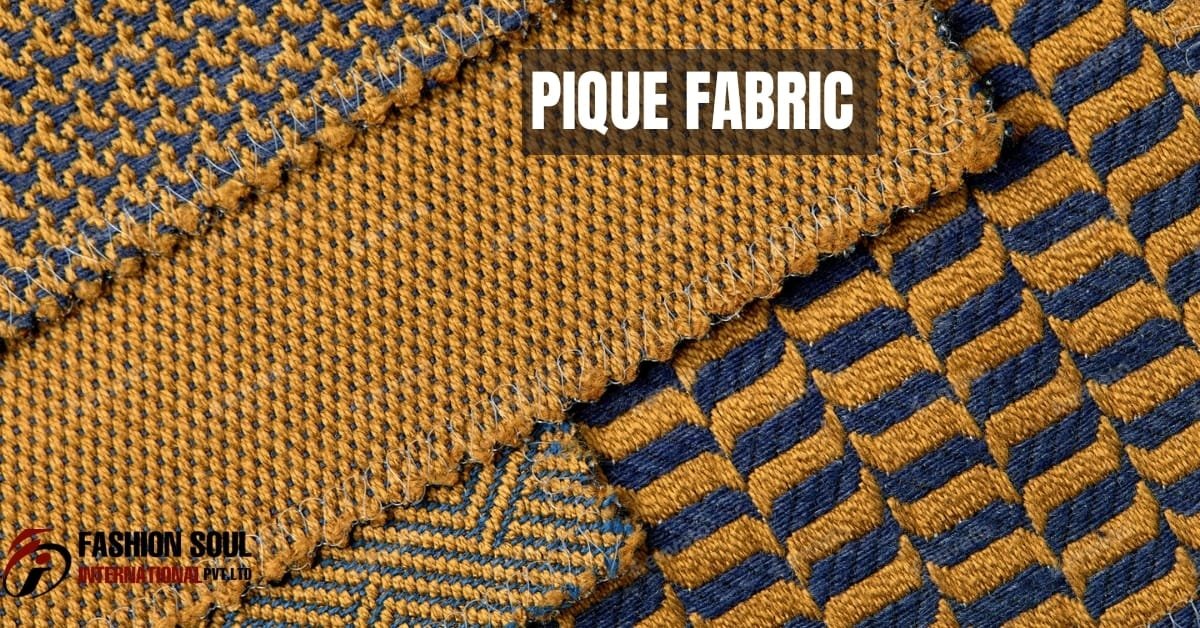

Great information